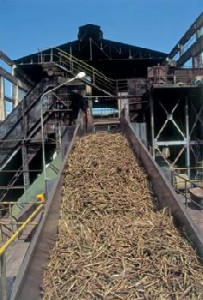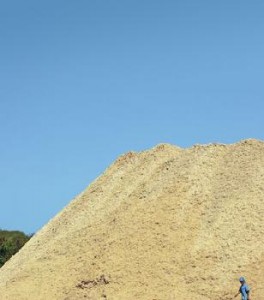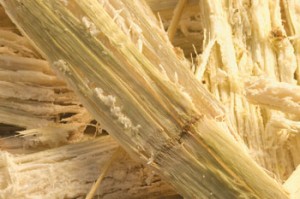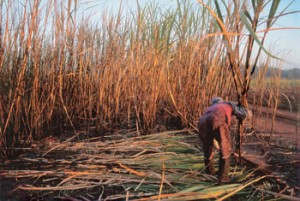
eduardo cesarOne ton of dry bagasse costs US$ 15, less than half the price of the sources available in the USAeduardo cesar
Brazilian research on second generation ethanol has achieved outstanding networking capacity. Restricted until a short time ago to isolated experiences conducted by companies and research groups, the search for ethanol extracted from cellulose is mobilizing a growing number of researchers, encouraged by research policies focused on increasing the productivity of Brazilian sugarcane ethanol. The target is to take advantage of sugarcane bagasse and trash, sources of cellulose that account for two-thirds of the plant’s energy, yet are not converted into biofuels. “A global race is taking place to develop second generation ethanol,” says Rubens Maciel Filho, a professor at the School of Chemical Engineering of the State University of Campinas/ Unicamp, and one of the coordinators of the Programa FAPESP de Pesquisa em Bioenergia/Bioen, Bioenergy Research Program, the driver of the scientific community’s networking in São Paulo. “This kind of research is relatively new in Brazil; nonetheless, it has comparative advantages in this race, such as the availability of an enormous quantity of cheap raw material, which is the pre-harvested bagasse, and an installed infra structure prepared to produce ethanol,” he states.
Residues such as wood chips, sugarcane bagasse and corn cobs contain cellulose and can be transformed into biofuel when submitted to hydrolysis, a chemical molecule-breaking process. A major advantage of this approach would be to reduce the competition between biofuels and food, to produce – in the case of using bagasse – more ethanol per plantation. One challenge is to make ethanol production less expensive – in the United States, corn-extracted ethanol is strongly subsidized, unlike Brazilian sugarcane ethanol. From the technical point of view, several hydrolysis pathways have already been tested, but the current yields and investments do not make these operations economically feasible.
The networking involves initiatives such as the construction of several pilot plants to develop the technological pathways of cellulose ethanol. The Dedini Indústrias de Base company is building a new acid hydrolysis plant – this is a process in which acid is used as a catalyst to break cellulose molecules. This plant will incorporate innovations related to materials and processes based on knowledge gained from 2003 to 2007, the period during which another plant owned by the company was in operation inside the Usina São Luiz mill in the city of Pirassununga, in São Paulo State. “The experience showed that we need to lighten some of the severe conditions under which the unit had been operating,” says José Luiz Olivério, vice president of Dedini. “We’re testing more resistant materials, because the abrasive conditions of the process resulted in wear-and-tear that jeopardized the continuous functioning of the unit,” he states. According to Olivério, Dedini has maintained its belief in the commercial feasibility of its technology, which has been studied since the 1980’s; this technology uses the Dedini Hidrólise Rápida/DHR Rapid Hydrolysis Process, which was a pioneering process in the country. The company has a scientific cooperation agreement with FAPESP, involving the research of industrial processes for the manufacturing of ethanol.
Oxiteno, one of the biggest Brazilian chemical companies, has shown interest in dominating the hydrolysis process of bagasse and trash to manufacture products used in the chemical and pharmaceutical industries. Oxiteno partnered with FAPESP in November 2006 to launch a bidding invitation – focused on 16 research theme areas – for the selection of projects in the field of sugar, ethanol and by-products production. The majority of the seven winning projects in course, which involve partnerships with researchers from the University of São Paulo, the Instituto de Pesquisas Tecnológicas, Technological Research Institute and the Laboratório Nacional de Luz, Síncrotron, Synchrotron Light Laboratory, are working on processes related to cellulose ethanol. The Foundation’s partnerships with Dedini and Oxiteno are part of the Bioen program.
Petrobras is investing in enzyme hydrolysis, which uses enzymes instead of acids. These enzymes are produced by microorganisms that break the sugar from the cellulose, which is then transformed into fuel ethanol after the fermentation process. A pilot plant installed at Cenpes, the company’s research center located on Ilha do Fundão island in Rio de Janeiro, went into operation in 2007. The company’s intention is to master this technology and export cellulose ethanol in the forthcoming decade.

HÉLVIO ROMERO/aeBagasse in sugar mill in the State of São Paulo: promising raw material for cellulose ethanolHÉLVIO ROMERO/ae
A pilot plant in Campinas, in the state of São Paulo, will be built by mid 2010. This pilot plant will be available to researchers from all states. A symbol of the networking efforts, the plant will be installed in the recently created Centro de Ciência e Tecnologia do Bio-etanol/CTBE, Bioethanol Science and Technology Center, linked to the Ministry of Science and Technology. The center’s infra structure will comprise six modules, ranging from the physical treatment of lignocellulose to the production of microorganisms, fermentation, and enzymatic hydrolysis. The idea is to allow researchers to conduct experiments using specific parts of the same platform. “The objective is to move forward simultaneously and thus overcome several technological bottlenecks linked to second generation ethanol,” explains Carlos Eduardo Vaz Rossell, coordinator of the CTBE’s pilot plant.
Basic research linked to second generation ethanol is also moving forward. Researchers from Embrapa Agroenergia, for example, are working on studies to describe the cell walls of sugarcane. The studies are on course at the Laboratório de Genética Molecular, Molecular Genetics Lab, at the Embrapa Recursos Genéticos e Biotecnologia, Genetic and Biotechnology Research Center, in partnership with USP’s Botanic Institute. The objective is to gain a better understanding of the composition and cell wall structure of sugarcane, to manipulate it in a specific way, aiming at increasing the production of second generation ethanol.
Countries such as the United States, Canada and Sweden have more outstanding scientific production than Brazil, in terms of the development of second generation ethanol. The United States, the world’s foremost ethanol producer, is being criticized because it is depending heavily on corn, a source of human food, to extract biofuel; in addition, US corn is heavily subsidized and, as such, it can be sold at a reasonable price. The objective of the search for cellulose ethanol, explored from farming residues or inedible plants, is to guarantee the supply of renewable fuel without jeopardizing the country’s food safety.
Brazil’s interest in cellulose ethanol has a different background. Brazil’s objective is to become even more competitive in terms of sugarcane ethanol, by increasing production without increasing the land necessary for sugarcane plantations in the same proportion. Studies conducted within the scope of the Projeto Bioetanol project, a research network funded by the federal government, show that a distillery that nowadays produces one million liters of ethanol from sugarcane juice could initially produce an additional 150 thousand liters of bagasse ethanol if it used the hydrolysis technology. In 2025, with improved technology, this same production would provide an additional 400 thousand liters from recovered bagasse. sugarcane trash is another potential source for ethanol extraction. As slashing and burning of sugarcane becomes less frequent, the trash will tend to be used as a source of cellulose.
In Brazil, the existing technology has to reduce costs to offset the change in the currently efficient use of sugarcane bagasse, which is burned to generate electricity at the sugar and ethanol mills. Rubens Maciel Filho, from Unicamp, points out that it is not enough to find technologically feasible solutions – they must also be low cost technologies. “It is no easy task to justify huge investments to improve first generation ethanol, because the productivity of the existing process is quite high; an additional challenge is to produce second generation ethanol at a competitive price,” he says. However, it is important to point out that the first generation technology still has space for improvement. In spite of investing in the development of the hydrolysis process, Dedini has not stopped focusing on incremental technologies, that range from the creation of self-sufficient – in terms of water – ethanol plants to the production of a biofertilizer that incorporates several residues, such as vinasse and soot. “sugarcane is unbeatable in terms of storing energy,” says Olivério, from Dedini.
It is difficult to predict how long it is going to take before second generation ethanol becomes economically feasible, given the difficulties in learning about the details of the progress achieved by companies, as such progress is protected by non-disclosure. “However, if a truly competitive process to transform sugarcane bagasse into ethanol actually existed, it would already be available for the market and the mills would already be using it,” says Rubens Maciel, from Unicamp. The researcher says that Brazil has five years to overcome the technological challenges. “Otherwise, we are going to depend on imported processes and inputs. But the effort is worthwhile because our advantage lies in the fact that we have the raw material – the bagasse- available at the ethanol producing unit,” he says, referring to the price of a ton of dry sugarcane bagasse, which costs approximately US$ 15, in comparison to the US$ 35 that the same quantity of the available residue costs in the United States. Even transportation costs are a competitive advantage, as the bagasse does not have to be transported to the plant – it is available on site.
 EDUARDO CESARBagasse and trash are comprised of cellulose, a glucose polymer formed by six carbons, the hexoses; of hemicellullose, comprised of five-carbon sugars, called pentoses, which are not used in sugar production; and of lignin, a structural material of the plant, and an integral part of the secondary cell walls of plants. Lignin is responsible for the plant’s hardness and impermeability and provides resistance to attacks on plant tissues. In order for the biomasses to be used as raw material for chemical and biological processes, they have to be submitted to a pre-treatment able to disorganize the recalcitrant lignocellulose complex. Lignin is a major obstacle in this process. The breakdown of lignin releases substances that inhibit fermentation.
EDUARDO CESARBagasse and trash are comprised of cellulose, a glucose polymer formed by six carbons, the hexoses; of hemicellullose, comprised of five-carbon sugars, called pentoses, which are not used in sugar production; and of lignin, a structural material of the plant, and an integral part of the secondary cell walls of plants. Lignin is responsible for the plant’s hardness and impermeability and provides resistance to attacks on plant tissues. In order for the biomasses to be used as raw material for chemical and biological processes, they have to be submitted to a pre-treatment able to disorganize the recalcitrant lignocellulose complex. Lignin is a major obstacle in this process. The breakdown of lignin releases substances that inhibit fermentation.
Several bottlenecks have to be overcome to achieve an economically feasible process. The first bottleneck is related to the pre-treatment of bagasse and trash. “The raw materials decompose slowly. The challenge is to pre-treat this structure to increase its lability. The early processes were very destructive and led to significant sugar loss,” says Rossell, from CTBE. “We still do not dominate the chemical, physical, and mechanical properties of bagasse, trash and their fractions. We need to become more familiar with the raw material to then develop more efficient processes in the future,” he states.
The second bottleneck is related to the catalysts used to decompose the cellulose. In the case of hydrolic acid, it is necessary to improve the efficiency of the process, which does not allow a very accurate control of the breaking of the chemical bonds. “While sulphuric acid destroys part of the sugar that is formed, the more efficient chloridic acid has a problem related to corrosiveness, which requires high-cost metal alloys,” says Rossell. In the case of the enzymatic hydrolysis process, the bottleneck is the cost of the enzymes and the exaggerated quantity needed to provoke the splitting of the cellulose into glucose. One of the challenges of the research studies is to find microorganisms able to produce more productive enzymes.
In the United States, research is focused on a technique called consolidated bioprocessing, in which the four biological transformations involved in the production of bio-ethanol (production of enzymes, saccharification, fermentation of the hexoses and fermentation of the pentose) happen in a single phase. Genetically modified microorganisms anaerobically produce enzymes with better activity than the ones used by other processes (read the interview). “These microorganisms need to be tested because even if they work well in the laboratory, they can be attacked by other enzymes that survive better in the environment,” says Maciel. “We cannot be left out of the development process of sophisticated microorganisms, because they can help us understand the process better and work in our favor.”
 MIGUEL BOYAYANOther bottlenecks include taking advantage of the five-carbon sugars, the so-called pentoses. “There is no efficient pathway to transform these sugars into ethanol. Most of the yeasts do not have this pathway or the pathway is so small that it does not produce any impact,” says Rossell. “The creation of new yeasts or microorganisms is critical for the transformation of pentose into ethanol. Nowadays, from the commercial point of view, we would only have ethanol obtained from hexoses.” There are other pending issues to resolve, such as the need for high water consumption in the pre-treatment process and the disposal of vinasse, the residue that is left over from the distillation to recover the ethanol . When the production of ethanol comes from hydrolysis, the residue does not contain potassium or phosphorus and thus cannot be used as a fertilizer. As vinasse is polluting, another safe destination is an issue.
MIGUEL BOYAYANOther bottlenecks include taking advantage of the five-carbon sugars, the so-called pentoses. “There is no efficient pathway to transform these sugars into ethanol. Most of the yeasts do not have this pathway or the pathway is so small that it does not produce any impact,” says Rossell. “The creation of new yeasts or microorganisms is critical for the transformation of pentose into ethanol. Nowadays, from the commercial point of view, we would only have ethanol obtained from hexoses.” There are other pending issues to resolve, such as the need for high water consumption in the pre-treatment process and the disposal of vinasse, the residue that is left over from the distillation to recover the ethanol . When the production of ethanol comes from hydrolysis, the residue does not contain potassium or phosphorus and thus cannot be used as a fertilizer. As vinasse is polluting, another safe destination is an issue.
Rossell views the perspectives optimistically. “The number of researchers and technicians involved in research tends to grow exponentially,” he states. In the opinion of Maciel, from Unicamp, the networking of efforts is fundamental to benefit the country’s competitive edge. – There has to be a certain amount of redundancy in any line of research so that the different ways of approaching a problem can be compared. However, in the case of cellulose ethanol, we might need many pilot plants. With some plants and the integrated mobilization of many researchers, we can achieve better results,” he concludes.
Uniting for sustainability
Workshop brings together North Americans, Brazilians and Argentines to debate the impact of biofuels on water and land use
There is a wide field in which researchers from Brazil, Argentina and the United States can join efforts to understand and reduce the impact of biofuel production technologies on the use of water and land. But in order to make these collaborations feasible, it will be necessary to overcome obstacles such as the lack of a data standard that tracks comparative studies, the need to build a model able to explain the effects of complex phenomena, or the need to find ways to scientifically analyze correlations, such as the ones suggesting the influence of the increase in the size of the corn-planted area in the United States, on the deforesting of Brazil’s Amazon Rainforest. This conclusion was voiced during the final discussions of a workshop held in August, which drew scientists from three countries with great interest in biofuels – while Brazil and the United States are the leading producers of bioethanol, one a by-product of sugarcane and the other a by-product of corn, Argentina has huge potential to produce both ethanol and biodiesel.
“Together, these countries from the American continent want to define high-quality scientific strategies so that natural resources are used in a sustainable manner,” says Marcos Buckeridge, a professor at the University of São Paulo/USP’s Biosciences Institute and coordinator of the workshop. The event, held within the scope of the Programa FAPESP de Pesquisa em Bioenergia/Bioen, Bionergy Research Program, was organized and sponsored by funding agencies such as FAPESP, the Conselho Nacional de Desenvolvimento Científico e Tecnológico/CNPq, and the US’s National Science Foundation, as well as such institutions as the University of São Paulo, the University of Buenos Aires and Iowa State University. “Water and land use, associated with the production of biofuels, has significant social, economic and environmental consequences and entails complex technological issues. New models, with multidisciplinary and multinational teams are necessary to address this issue,” said Robert Anex, a professor at Iowa State University.